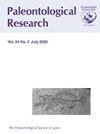微x射线计算机断层扫描评估浮游有孔虫壳对海洋酸化和全球变暖的响应
IF 0.6
4区 地球科学
Q3 PALEONTOLOGY
引用次数: 0
摘要
摘要海洋酸化正在加速,这主要是由于海洋吸收了自工业革命以来大约50%的人为排放的二氧化碳。众所周知,许多海洋钙化生物,如有孔虫和球石,都是利用周围海水中的碳酸盐离子来构建外壳的。碳酸盐饱和状态对有孔虫钙化有重要影响,有孔虫产壳对海洋pCO2的增加非常敏感。此外,海洋变暖也随着酸化而发展。因此,这两种环境变化都可能影响有孔虫的壳形成。然而,有孔虫壳参数(即大小、重量、体积和密度)与海洋二氧化碳分压或海面温度(SST)或两者之间的关系尚不清楚。本文利用东海晚第四纪沉积岩心MD98-2196中浮游有孔虫gloigerinoides ruber(白色)化石,研究了该岩心壳参数与海洋性质的关系。使用高分辨率微x射线计算机断层扫描(MXCT)扫描有孔虫壳,以确定壳的体积和密度。结果表明:壳的归一化重量和归一化体积与海温和大气pCO2呈负相关;重量/体积与大气pCO2的负相关关系与前人的实验室实验和上新世的地质记录一致。然而,重量/体积与海温之间的相关性应该谨慎解释,因为它可能是由于海温与大气二氧化碳分压之间的相关性造成的。另一方面,壳密度与海温和二氧化碳的相关性较弱或不显著,说明这些环境参数对壳密度没有影响。因此,未来的海洋酸化将对浮游有孔虫的碳酸盐生产力产生负面影响,即使它不会影响壳密度。温度对浮游有孔虫壳形成的影响可能远小于海洋酸化对温度敏感性的影响。本文章由计算机程序翻译,如有差异,请以英文原文为准。
Response of Planktic Foraminiferal Shells to Ocean Acidification and Global Warming Assessed Using Micro-X-Ray Computed Tomography
Abstract. Ocean acidification is now progressing, primarily due to the fact that the oceans have absorbed about 50% of the anthropogenic CO2 emitted since the industrial revolution. Many marine calcifying organisms, such as foraminifers and coccoliths, are known to build their shells using carbonate ions present in the seawaters surrounding them. Carbonate saturation state has a crucial influence on foraminiferal calcification, and foraminiferal shell production is known to be sensitive to increase in ocean pCO2. Moreover, ocean warming is also progressing along with acidification. Therefore, both environmental changes could affect foraminiferal shell formation. However, the relationship between foraminiferal shell parameters (i.e., size, weight, volume, and density) and ocean pCO2 or sea surface temperature (SST), or both, remains unclear. In this study, we used fossil planktic foraminifer Globigerinoides ruber (white) in a late Quaternary sediment core (MD98-2196) from the East China Sea to investigate a relationship between the shell parameters and oceanographic properties estimated based on the proxies from the same core. The foraminiferal shells were scanned using high-resolution micro-X-ray computed tomography (MXCT) to determine shell volume and density. The results showed that the size-normalized weight and the size-normalized volume of the shell had a negative correlation with the SST and atmospheric pCO2. The negative correlation between weight/volume and atmospheric pCO2 agrees with the previous laboratory experiments and geological record during the Pliocene. However, the correlation between weight/volume and SST should be interpreted with caution because it might be an artifact due to the correlation between SST and atmospheric pCO2. On the other hand, shell density is only weakly or insignificantly correlated with SST and pCO2, suggesting that these environmental parameters do not exert any impact on shell density. Thus, future ocean acidification will negatively affect the carbonate productivity of planktic foraminifers, even if it will not affect shell density. The temperature effect on the shell formation of the planktic foraminifers might be much less than ocean acidification considering controversial results of the temperature sensitivity in previous studies.
求助全文
通过发布文献求助,成功后即可免费获取论文全文。
去求助
来源期刊

Paleontological Research
PALEONTOLOGY-
CiteScore
1.60
自引率
0.00%
发文量
47
审稿时长
>12 weeks
期刊介绍:
Paleonotological Research (PR) is a quarterly, peer-reviewed international journal, which focuses on original contributions primarily in the area of paleontology but also covering a wide range of allied sciences. It has been published since 1997 as a successor to the former journal Transactions and Proceedings of the Palaeontological Society of Japan. The emphasis of contributions will include global and local perspectives, and contents can cover all ages (Precambrian to the Quaternary, including the present time).
 求助内容:
求助内容: 应助结果提醒方式:
应助结果提醒方式:


